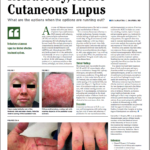Incorrect
A) Pustular ‘Id’ reaction
An id reaction is a cutaneous autosensitization response to a remote infection, usually of the dermatophyte type. The reaction is characterized by pustules and/or vesicles distributed symmetrically, most commonly occurring on the palms and soles. The lesions can coalesce to form large scaling patches and plaques, creating a clinical appearance that resembles palmoplantar pustular psoriasis. A remote infection, which was absent in this patient, is required to make this diagnosis. Id reactions generally clear with treatment of the remote infection.
Dr. Femia is a fellow in the dermatology–rheumatology fellowship at Brigham and Women’s Hospital in Boston. She is a diplomat of the American Board of Dermatology.
Dr. Merola is an instructor in the department of dermatology at Harvard Medical School and a fellow in the rheumatology division at Brigham and Women’s Hospital, both in Boston. He is the assistant program director for the combined medicine–dermatology training program and a diplomat of the American Board of Dermatology and the American Board of Internal Medicine.
